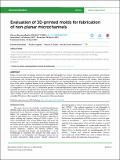Evaluation of 3D-printed molds for fabrication of non-planar microchannels
Author(s)
Parthiban, Pravien; Vijayan, Sindhu; Doyle, Patrick S; Hashimoto, Michinao
DownloadPublished version (2.541Mb)
Publisher Policy
Publisher Policy
Article is made available in accordance with the publisher's policy and may be subject to US copyright law. Please refer to the publisher's site for terms of use.
Terms of use
Metadata
Show full item recordAbstract
Replica obtained from micromolds patterned by simple photolithography has features with uniform heights, and attainable microchannels are thus quasi-two-dimensional. Recent progress in three-dimensional (3D) printing has enabled facile desktop fabrication of molds to replicate microchannels with varying heights. We investigated the replica obtained from four common techniques of 3D printing-fused deposition modeling, selective laser sintering, photo-polymer inkjet printing (PJ), and stereolithography (SL)-for the suitability to form microchannels in terms of the surface roughness inherent to the mechanism of 3D printing. There have been limited quantitative studies that focused on the surface roughness of a 3D-printed mold with different methods of 3D printing. We discussed that the surface roughness of the molds affected (1) transparency of the replica and (2) delamination pressure of poly(dimethylsiloxane) replica bonded to flat glass substrates. Thereafter, we quantified the accuracy of replication from 3D-printed molds by comparing the dimensions of the replicated parts to the designed dimensions and tested the ability to fabricate closely spaced microchannels. This study suggested that molds printed by PJ and SL printers were suitable for replica molding to fabricate microchannels with varying heights. The insight from this study shall be useful to fabricate 3D microchannels with controlled 3D patterns of flows guided by the geometry of the microchannels.
Date issued
2021Department
Massachusetts Institute of Technology. Department of Chemical EngineeringJournal
Biomicrofluidics
Publisher
AIP Publishing
Citation
Parthiban, Pravien, Vijayan, Sindhu, Doyle, Patrick S and Hashimoto, Michinao. 2021. "Evaluation of 3D-printed molds for fabrication of non-planar microchannels." Biomicrofluidics, 15 (2).
Version: Final published version